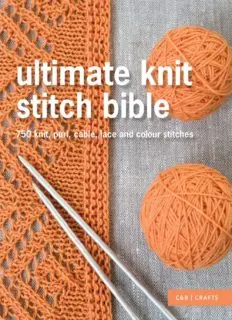
Ultimate Knit Stitch Bible. 750 Knit, Purl, Cable, Lace and Colour Stitches PDF
Preview Ultimate Knit Stitch Bible. 750 Knit, Purl, Cable, Lace and Colour Stitches
ultimate knit stitch bible ultimate knit stitch bible 750 knit, purl, cable, lace and colour stitches contents Introduction Tools and equipment Starting off Key to stitch diagrams Abbreviations Knit and purl stitches Cable and aran stitches Lace and eyelet stitches Colourwork stitches Edgings and trims Index Acknowledgements Introduction Whether you’re a knitting novice who is picking up a pair of needles for the first time, or a seasoned professional with years of experience, you will find inspiration and technical know-how within these pages; there is always something to learn and to pass on. This book is divided into five sections. The first one introduces basic combinations of knit and purl. These two stitches can be configured into patterns and constructed into all kinds of fabrics. Texture is the main inspiration for this section. The second section features cable and aran stiches. These patterns are traditionally romantic, rugged and instantly recognizable; they create wonderful surface interest and give scale to any knitted fabric. You can apply these patterns to an Aran sweater; these are characterized by a large central panel bordered by varying numbers of side panels on a textural background. Usually symmetrical, these side panels are knitted in simpler stitch patterns – a useful device for scaling up larger sizes. Even the welts, cuffs and neckbands can be worked with complex stitches to create highly decorative and unique textiles. Lace and eyelets are the focus of the third section. These intricate stitches are intriguing and absorbing and offer endless possibilities for experimentation. For the beginner knitter, lace knitting may seem daunting as it requires a little more technique – wrapping the yarn around the needle a few times, dropping a stitch or two, or (intentionally) slipping unknitted stitches over a knitted one, for example. However, the sense of accomplishing a simple eyelet will encourage you to attempt and experiment with the more complex and challenging effects. The fourth section focuses on colourwork, with most of the designs drawing inspiration from traditional Scottish and Scan-dinavian patterns knitted using the Fair Isle technqiue. Fair Isle knitting uses design repeats and motifs in horizontal and vertical bands, and in small and large panels. Typically, these patterns feature diagonal lines, which means that the colour-change positions are offset, creating an elastic fabric. No more than two colours are used in any row, one colour being ‘stranded’ across the back of the other. There is also a symmetry to the patterns, which means they can be easily memorized. Intarsia knitting is a similar technique, though yarn is usually not stranded across the back of the work and patterns often involve larger blocks of colour and picture motifs. The final section concentrates on edgings and trims. From simple yet decorative ribs to intricate lace borders, there is an almost endless variety of edgings. They offer a quick way of turning a plain knit garment into something supremely stylish. Often you will be able to simply add the edging to an existing pattern, but if you need to make some calculations to make a new trim fit an old pattern, you will find advice here. It is usually possible to combine an existing pattern with a fresh edging. As most edgings are worked over just a few stitches, it is easy to knit up a few centimetres to see how a pattern might suit your project. Tools and equipment To master any skill, it is imperative to have a solid foundation in the techniques. This section provides useful information for knitting.
